![]()
![]()
![]()
Use LEFT and RIGHT arrow keys to navigate between flashcards;
Use UP and DOWN arrow keys to flip the card;
H to show hint;
A reads text to speech;
21 Cards in this Set
- Front
- Back
- 3rd side (hint)
|
Elements in the SAME GROUP have |
Similar chemical properties. Properties are not identical. |
They arent identical |
|
|
Soft metallic solids, have low ionization energy, low density, low melting point, compounds in nature, |
Alkali Metals 1A |
|
|
|
Prototypical nonmetals, "salt formers," large negative electron affinities,reacts directly w/ metals form metal halides |
Halogens 7A |
|
|
|
In any atom this is attracted to the nucleus and repelled by other electrons |
Electrons |
|
|
|
The force that an electron experiences depends on both factors (attraction to nucleus & repel electrons) |
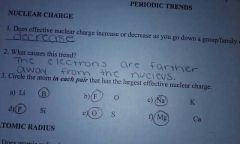
Nuclear Charge |
|
|
|
Defined as one-half of the distance between covalenty bonded nuclei |
The bonding atomic radius |
|
|
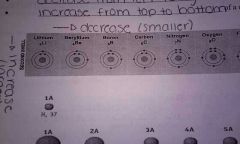
Decrease from left to right across a row, Increase from top to bottom of a column |

Bonding atomic radius (size of atoms) |
|
|
|
Which two periods have the same number of elements |
4 & 5 |
|
|
|
Most reactive of nonmetals |
Halogens |
|
|
|
Compare to alkali metals, alkaline-earth metals |
Are less reactive |
|
|
|
Across a period, atomic radii |
Gradually decrease |
|
|
|
Are smaller than there parent atoms, becomes this when outermost electron is removed and repulsions are reduced |
Cations |
|
|
|
Larger than their parents, becomes this when electrons are added and repulsions are increased |
Anion |
|
|
|
Increase size as you go down a column, |

Ions (iconic size decreases with an increasing nuclear charge) |
|
|
|
Amount of energy required to remove an electron from the ground state of a gaseous atom or ion |

Ionization Energy |
|
|
|
As one goes down a column how much energy is required to remove the first electron |
Less energy |
|
|

Energy change a company addition of electron to gaseous atom |
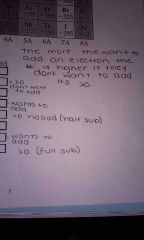
Electron Affinity |
|
|
|
Electron affinity becomes more exothermic as you go .... |
From left to right across a row |
|
|
|
Measure of an atom's attraction for the shared pair of electrons in a bond |
Electronegativity |
|
|
|
across a period electronegativity |
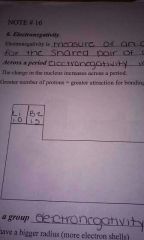
Increases |
|
|
|
Down a group electronegativity |
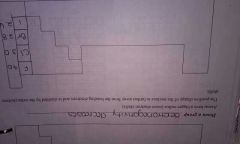
Decreases |
|

